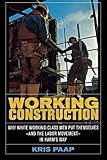Working Construction : Why White Working-Class Men Put Themselves—and the Labor Movement—in Harm's Way / Kris Paap.
Material type: TextPublisher: Ithaca, NY : Cornell University Press, [2018]Copyright date: ©2006Description: 1 online resource (272 p.) : 1 chart/graphContent type:
TextPublisher: Ithaca, NY : Cornell University Press, [2018]Copyright date: ©2006Description: 1 online resource (272 p.) : 1 chart/graphContent type: - 9781501729294
- Construction industry -- United States -- Safety measures
- Construction workers -- United States -- Attitudes
- Masculinity -- United States
- Men, White -- United States -- Attitudes
- Working class men -- United States -- Attitudes
- Labor History
- Sociology & Social Science
- POLITICAL SCIENCE / Labor & Industrial Relations
- 331.7/6240973 22
- HD8039.B892 U66 2006
- online - DeGruyter
| Item type | Current library | Call number | URL | Status | Notes | Barcode | |
|---|---|---|---|---|---|---|---|
 eBook
eBook
|
Biblioteca "Angelicum" Pont. Univ. S.Tommaso d'Aquino Nuvola online | online - DeGruyter (Browse shelf(Opens below)) | Online access | Not for loan (Accesso limitato) | Accesso per gli utenti autorizzati / Access for authorized users | (dgr)9781501729294 |
Frontmatter -- Contents -- Acknowledgments -- Introduction: Working Construction -- 1. The Political and Economic Relations of the Construction Industry -- 2. The Social Relations of Production -- 3. "A Bitch, a Dyke, or a Whore .. . ":How Good Men Justify White and Male Dominance -- 4. Bodies at Work: The Social and Physiological Production of Gender -- 5. "We're Animals ... And We're Proud of It": Strategic Enactments of White Working-Class Masculinities -- 6. The Bodily Costs of This Social Wage: Occupational Safety in the Construction Industry -- 7. The Wages-and Costs-of White Working-Class Masculinities -- Appendix: The Benefit of Being "Dumb as Rocks" -and Other Methodological Topics -- Notes -- References -- Index
restricted access online access with authorization star
http://purl.org/coar/access_right/c_16ec
Kris Paap worked for nearly three years as a carpenter's apprentice on a variety of jobsites, closely observing her colleagues' habits, expressions, and attitudes. As a woman in an overwhelmingly male—and stereotypically "macho"—profession, Paap uses her experiences to reveal the ways that gender, class, and race interact in the construction industry. She shows how the stereotypes of construction workers and their overt displays of sexism, racism, physical strength, and homophobia are not "just how they are," but rather culturally and structurally mandated enactments of what it means to be a man—and a worker—in America.The significance of these worker performances is particularly clear in relation to occupational safety: when the pressures for demonstrating physical masculinity are combined with a lack of protection from firing, workers are forced to ignore safety procedures in order to prove—whether male or female—that they are "man enough" to do the job. Thus these mandated performances have real, and sometimes deadly, consequences for individuals, the entire working class, and the strength of the union movement.Paap concludes that machismo separates the white male construction workers from their natural political allies, increases their risks on the job, plays to management's interests, lowers their overall social status, and undercuts the effectiveness of their union.
Mode of access: Internet via World Wide Web.
In English.
Description based on online resource; title from PDF title page (publisher's Web site, viewed 26. Apr 2024)


